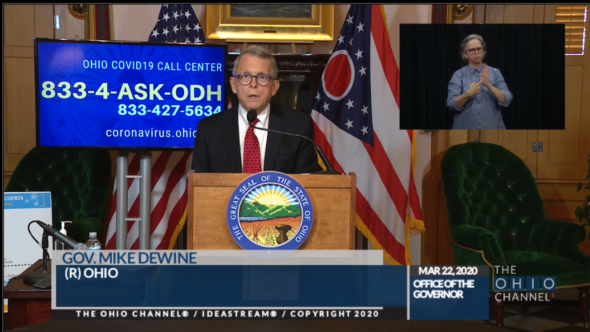
Screenshot from Gov. Mike DeWine's March 22 press briefing, live-streamed at ohiochannel.org
Stay at home order; first Greene County case: Highlights from March 22 governor’s briefing
- Published: March 22, 2020
“Today is the day.” —Dr. Amy Acton
Ohioans are being ordered to stay at home to help contain the spread of COVID-19 in the state, Gov. Mike DeWine announced at today’s press briefing.
“We are at an absolutely crucial time in this war,” he said in reference to Ohio’s sweeping efforts to curb the number of people who get sick and die from the virus.
The order goes into effect tomorrow night, Monday, March 23, at 11:59 p.m., through April 6 at 11:59 p.m.
Also today, Greene County saw its first confirmed case of COVID-19, as known cases in the state surged to 351.
The individual who tested positive in Greene County is en employee at Wright-Patterson Air Force Base, according to a March 21 press release from the base.
Greene County Public Health released the news the next day, with the following statement: “The individual and identified contacts have self-isolated at home and monitoring is being done by Greene County Public Health. To protect the identities of the case and contacts, no additional information is being released. There was no exposure of history through travel, which indicates this person became ill through community spread.”
The News will report on the Greene County case as more details become available.
Details on stay at home order
The most sweeping of Ohio’s orders to date, the stay at home order requires people to remain at their place of residence except to perform certain essential activities. Outlined in the order, these activities include obtaining groceries and other necessary household supplies, obtaining medications or visiting health care professionals, engaging in outdoor activities, performing certain types of essential work and helping with the care of family and friends.
Walking pets and exercising outdoors is allowed and encouraged, DeWine stated at the briefing, describing the order and its exemptions as “commonsense.”
“Get out and find a place you can walk,” he advised.
Also specified in the order, nonessential businesses in Ohio must cease operations except for minimum necessary activities, which include making provisions for employees to work remotely.
The order exempts a list of “essential businesses and operations” that will continue to function. These include healthcare and public health, human services, essential government functions, essential infrastructure, stores that sell groceries and medicine, gas stations, banks and financial institutions, restaurants for carryout and delivery and other specified business types. Media services and “first amendment protected speech” are also exempted from the order.
For these exempted businesses, the order requires that workplaces implement social distancing protocols, such as keeping six feet between workers, making hand sanitizer available and maintaining separate operating hours for vulnerable populations.
The full order is 12 pages, with an additional lengthy memo from the Department of Homeland Security that identifies “essential critical infrastructure workers during COVID-19 response.” Click here to read the order.
In issuing the order, Ohio joins a growing list of states and cities across the U.S. that are requiring residents to stay at home, also called “shelter in place.” California, Oregon, New York, Connecticut, New Jersey and Illinois have implemented their own versions of these orders. Earlier today, the New York Times reported that 1 in 4 Americans are now subject to stay at home orders, prior to Ohio’s announcement.
Ohio’s order will be enforced by the state’s 113 local public health departments and local law enforcement. In response to a question from a reporter, DeWine clarified that those who don’t comply could be charged with a second-degree misdemeanor. But he stressed that the order is “not designed to be punitive.”
Still, he underscored the seriousness of the state’s new order, noting that it was “a health order, not a health suggestion.”
Daycare centers, business resources
DeWine also addressed the status of daycare centers in the state. Starting on Thursday, March 26, all day care centers that remain open will be operating under a “temporary pandemic license” through April 30, with a possible extension beyond that date. The pandemic license requires a maximum of six children in a room, as well as other guidelines for caregivers.
DeWine noted that Ohioans have already pulled their children out of daycare in great numbers. State-subsidized centers have seen a dramatic drop from 117,000 to 17,000 children over the past three weeks, he said.
Addressing Ohio businesses, Lt. Gov. Jon Husted said today that information and resources have been centralized at a new website, coronavirus.ohio.gov/businesshelp.
351 confirmed cases; first case in Greene County
Also at today’s press briefing, Ohio Health Director Dr. Amy Acton updated the state’s official COVID-19 tallies. The state now has 351 confirmed cases of COVID-19, up from 247 on Saturday. She continued to characterize the case number as “the tip of the iceberg.”
Greene County now has its first reported case. A total of 40 counties, or almost half of Ohio’s 88 counties, are reporting known cases of the virus.
There have been 83 hospitalizations, and 3 deaths. The number of deaths is unchanged from Saturday, though Acton acknowledged yesterday that the state’s recorded deaths lagged that of local news reports.
Action sounded a strong note of urgency, as well as ultimate optimism.
“Today is the day,” she said. “We have to batten down the hatches.”
Yet Acton said she felt hopeful that individual and state actions would make a difference in the outcome of the public health crisis.
“I do see us on the other side,” she said.
The Yellow Springs News encourages respectful discussion of this article.
You must login to post a comment.
Don't have a login? Register for a free YSNews.com account.













No comments yet for this article.